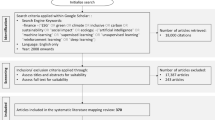Abstract
This article is the preamble to a set of articles describing initial results from an on-going European Commission funded, 5th Framework project called OMNIITOX, Operational Models aNd Information tools for Industrial applications of eco/TOXicological impact assessments. The different parts of this case study-driven project are briefly presented and put in relation to the aims of contributing to an operational life cycle-impact assessment (LCIA) model for impacts of toxicants. The present situation has been characterised by methodological difficulties, both regarding choice of the characterisation model(s) and limited input data on chemical properties, which often has resulted in the omission of toxicants from the LCIA, or at best focus on well characterised chemicals. The project addresses both problems and integrates models, as well as data, in an information system- the OMNIITOX IS. There is also a need for clarification of the relations between the (environmental) risk assessments of toxicants and LCIA, in addition to investigating the feasibility of introducing LCA into European chemicals legislation, tasks that also were addressed in the project. Keywords: Case studies; characterisation factor; chemicals; environmental risk assessment; hazard assessment; information system; life cycle impact assessment (LCIA); potentially toxic substances; regulation; risk assessment; risk ranking
Similar content being viewed by others
References
Aldridge WN (1996): Mechanisms and concepts in toxicology. Taylor & Francis, London, UK
Allanou R, Hansen BG, van der Bilt Y (1999): Public Availability of Data on EU High Production Volume Chemicals, EUR 18996 EN, European Commission, Joint Research Centre, Institute for Health and Consumer Protection, European Chemicals Bureau, TP 280, Ispra (VA), 21020, Italy
Allen TFH, Hoekstra TW (1992): Toward a unified ecology. Columbia University press, New York, USA
Bare JC, Hofstetter P, Pennington DW, Udo de Haes HA (2002): Life cycle impact assessment workshop summary. Midpoints versus endpoints: The sacrifices and benefits. Int J LCA 5:319–326
BUS (1984): Okobilanzen von Packstoffen. Bundesamt fur Umveltschutz, Schriftenreihe Umveltschutz, no. 24 (Bern, Schweiz)
BUWAL (1990): Methodik für Ökobilanzen auf der Basis ökologischer Optimierung. Schriftenreihe Umwelt, no. 133, Abfalle, Bundesamt für Umwelt, Wald & Landschaft (Bern, Schweiz)
Carlson R, Erixon M, Pålsson A-C, Tivander J (2004): OMNIITOX con- cept model supports characterisation modelling for life cycle impact assessment. Int J LCA 9 (5) 289–294
CEC (Commission of the European Community) 1996. EUSES, the European Union System for Evaluation of Substances. National Institute of Public Health and the Environment (RIVM), the Netherlands. Available from the European Chemicals Bureau (JRC), Ispra, Italy
CEC (Commission of the European Communities) 1999. Establishing the Ecological Criteria for the award of the Community Eco-label to Laundry Detergents (1999/476/EC), Official Journal of the European Communities L187/52-68, Brussels, Belgium, 20.07.1999
CEC (Commission of the European Community) (2001): White paper: Strategy for a Future Chemicals Policy. COM (2001) 88 final (Brussels, Belgium)
CEC (Commission of the European Community) (2003a): Communication from the Commission to the Council and the European Parliament-Integrated Product Policy—Building on Environmental Life-Cycle Thinking. COM(2003) final (Brussels, Belgium)
CEC (Commission of the European Community) (2003b): Technical Guidance Document on Risk Assessment in support of Commission Directive 93/67/EEC on Risk Assessment for new notified substances, Commission Regulation (EC) No 1488/94 on Risk Assessment for existing substances, Directive 98/8/EC of the European Parliament and of the Council concerning the placing of biocidal products on the market. Institute for Health and Consumer Protection, European Chemicals Bureau
Commission directive 93/67/EEC of 20 July 1993 laying down the principles for assessment of risks to man and the environment of substances notified in accordance with Council Directive 67/548/EEC
Commission regulation (EC) No 1488/94 of 28 June 1994 laying down the principles for risk assessment to man and the environment of existing substances in accordance with Council Regulation (EEC) No 793/93
Council Directive 67/548/EEC on the approximation of laws, regulations and administrative provisions relating to the classification, packaging and labelling of dangerous substances. Official Journal B 196 , 16/08/1967
Council Directive 92/32/EEC of 30 April 1992 amending for the seventh time Directive 67/548/EEC on the approximation of the laws, regulations and administrative provisions relating to the classification, packaging and labelling of dangerous substances. Official Journal L 154, 05/06/1992
Council Regulation (EEC) 793/93 of 23 March 1993 on the evaluation and control of the risk of existing substances. Official Journal L 84, 5.4.1993
Christensen FM, Olsen SI (2004): The potential role of life cycle assessment in regulation of chemicals in the European Union. Int J LCA 9 (5) 327–332
Davis G, Fort D, Hansen BG, Irwin F, Jones B, Jones S, Socha A, Wilson R, Haaf B, Gray G, Hoffman B (1997): Framework for Chemical Ranking and Scoring Systems. Chapter 1 in: Chemical ranking and scoring: Guidelines for relative assessment of chemicals, Swanson MB, Socha AC (eds.), pp 1-29. SETAC-US. Proceedings from the Pellston workshop on Chemical ranking and scoring, 12-16 February, 1995 (Sandestin, Florida)
Erixon M, Carlson R, Flemstrom K, Pålsson AC (2004): The data quality foundation in OMNIITOX information system. Int J LCA 9 (5) 333
Goedkoop, M. & R. Spriensma, 1999. The Eco-indicator 99. A damage oriented method for life cycle Impact assessment. PRe Consultants, Amersfoort
Guinée JB, Gorree M, Heijungs R, Huppes G, Kleijn R, de Koning A, van Oers L, Wegener Sleeswijk A, Suh S, Udo de Haes HA, de Bruijn H, van Duin R, Huijbregts MAJ (2002): Handbook on Life Cycle Assessment. Operational Guide to the ISO Standards. Kluwer Academic Publishers, Dordrecht, 2002, xii + 692 pp
Guinée JB, de Koning A, Pennington DW, Rosenbaum R, Hauschild M, Olsen SI, Molander S, Bachmann TM, Pant R (2004): Bringing science and pragmatism together in a tiered approach for modelling toxicological impacts in LCA. Int J LCA 9 (5) 320–326
Hauschild M, Wenzel H, (1998): Environmental Assessment of products. Volume 2: Scientific background. Chapman & Hall, London
Hertwich EG, Hammitt JK (2001): A Decision-Analytic Framework for Impact Assessment. Part II: Midpoints, Endpoints, and Criteria for Method Development. Int J LCA 6 (5) 265–272
Huijbregts MAJ (1999): Priority assessment of toxic substances in LCA. Development and application of the multi-media fate, exposure and effect model USES-LCA. IVAM environmental research, University of Amsterdam, Amsterdam
ISO 14040 (1997): Environmental management—Life Cycle Assessment -Principles and Framework
ISO14041 (1998): Environmental management—Life Cycle Assessment -Goal and scope definition and inventory analysis
ISO 14042 (2000): Environmental management—Life Cycle Assessment -Life cycle impact assessment
ISO/TS 14048 (2002): Environmental management—Life Cycle Assessment - Data documentation format
Jolliet O, Margni M, Charles R, Humbert S, Payet J, Rebitzer G, Rosenbaum R, (2003): IMPACT 2002+: A new life cycle impact assessment methodology. Int J LCA 8 (6) 324–330
Larsen HF, Birkved M, Hauschild M, Pennington DW, Guinee JB, (2004): Evaluation of selection methods for toxicological impacts in LCA: Recommendations for OMNIITOX. Int J LCA 9 (5) 307–319
Levin SA, Harwell MA, Kelly JR, Kimball KD, (eds.) (1989): Ecotoxicology - Problems and approaches. Springer-Verlag, New York, USA. Esp. chapters 3-6
Lidholm P, Bostrom S, Gunnarsson C, Rydberg T (2002): Vehicle industry case study—Preliminary results. Platform presentation at SETAC Europe annual conference Vienna, May 2002 (available at http://www. omniitox.net/Results/SETAC%2002/Setac final Peter.pdf)
Molander S, (2002): Refined Problem Definition for the OMNHTOX project. Report to the OMNHTOX-project deliverable D8 final, with contributions of Veronica Borghi and Pere Fullana, November 2002, Environmental Systems Analysis, Chalmers University of Technology (Goteborg, Sweden)
Newman MC, (1998): Fundamentals of Ecotoxicology. Ann Arbor Press, Chelsea, Michigan, USA, p 213
Pant R, Van Hoof G, Schowanek D, Feijtel TCJ, de Koning A, Hauschild M, Pennington DW, Olsen SI, Rosenbaum R, (2004): Comparison between 3 different LCIA methods for aquatic ecotoxicity and a product environmental risk assessment—Insights from a detergent case study within OMNIITOX. Int J LCA 9 (5) 295–306
Peterson DL, Parker VT, (eds) (1998): Ecological scale: Theory and applications, Columbia University Press, New York, USA
Saouter E, Feijtel TCJ, (2000): Use of Life Cycle Analysis and Environmental Risk Assessment in an Integrated Product Assessment. Environmental Strategies. Nordic Workshop, Vedbaek 1999, ISBN 92-893-0464-2. In: Hauschild M, Olsen SI, Poll C, Bro-Rasmussen F, (eds 2000): Risk Assessment and Life Cycle Assessment, TemaNord 2000:545. Nordic Council of Ministers, Copenhagen, 81–97
Udo de Haes H, Jolliet O, Finnveden G, Goedkoop M, Hauschild M, Hertwic E, Hofstetter P, Klopffer W, Krewitt W, Lindeijer E, Mueller-Wenk R, Olson S, Pennington D, Potting J, Steen B, (2002): Life-cycle impact assessment: Striving towards best practice. SETAC Press, Pensacola, Florida, USA
Author information
Authors and Affiliations
Corresponding author
Rights and permissions
About this article
Cite this article
Molander, S., Lidholm, P., Schowanek, D. et al. OMNIITOX - operational life-cycle impact assessment models and information tools for practitioners. Int J LCA 9, 282–288 (2004). https://doi.org/10.1007/BF02979417
Received:
Accepted:
Issue Date:
DOI: https://doi.org/10.1007/BF02979417




